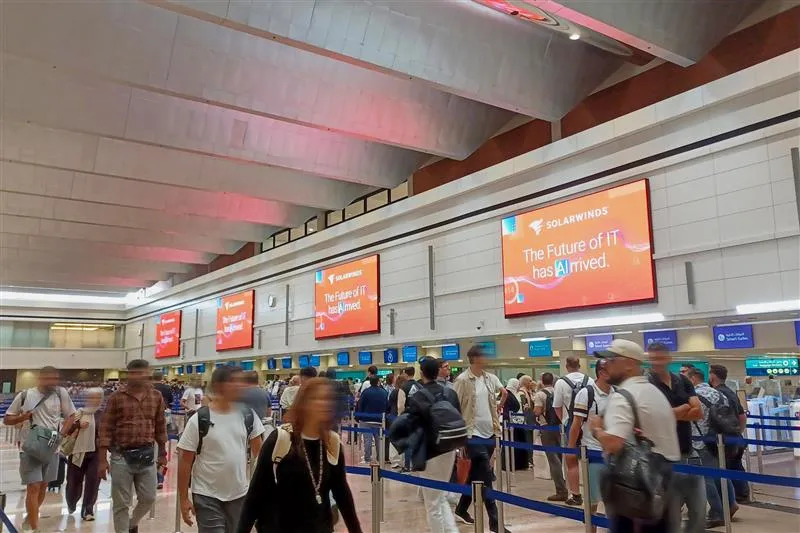
Airport Advertising Format Analysis Matching Brands to Strategic Placements

October 15, 2025 · 8 min read
by Harshit Dabhi
1. Alokozay on Trolley Advertisements
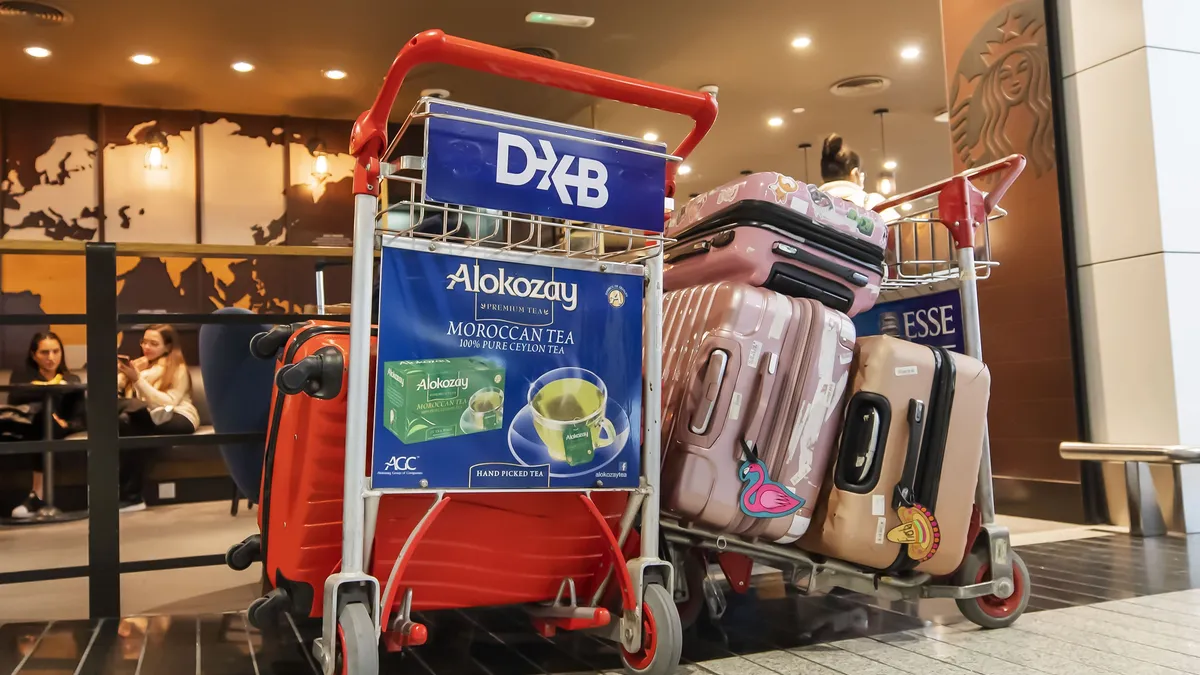
Industry: Fast-Moving Consumer Goods (FMCG) - Tea & Beverages
Why This Format Works:
Trolley advertising is exceptionally well-suited for Alokozay's FMCG positioning because it provides prolonged exposure during one of the most practical moments of the passenger journey. As travellers navigate through the airport pushing trolleys laden with luggage, they experience extended contact time with the brand—often 15-30 minutes from collection to check-in or arrival hall to taxi rank.
Strategic Advantages:
- High dwell time: Passengers physically interact with the branded surface throughout their airport experience
- Practical association: The trolley's utility creates positive brand sentiment through functional assistance
- Mass reach: Nearly universal usage amongst international travellers with luggage
- Premium positioning: Associates the brand with travel, cosmopolitanism, and lifestyle aspiration
Time of Year Considerations:
- Peak effectiveness: Summer holidays (June-August) and winter breaks (December-January) when family travel peaks and FMCG purchase patterns shift toward gifting and bulk buying
- Ramadan/Eid periods: Particularly effective in Middle Eastern airports when tea consumption traditionally increases and gifting culture drives premium product purchases
- Year-round relevance: FMCG products maintain consistent demand, making trolley ads a stable investment across all seasons
Industry-Specific Rationale:
For a tea and beverage company, airport environments represent premium positioning. International travellers represent higher-income demographics who purchase premium FMCG products. The extended exposure time allows Alokozay to communicate quality messaging, product variants, and brand heritage—crucial for differentiation in competitive beverage markets.
2. AYS Developer on Inflight Screen Advertising
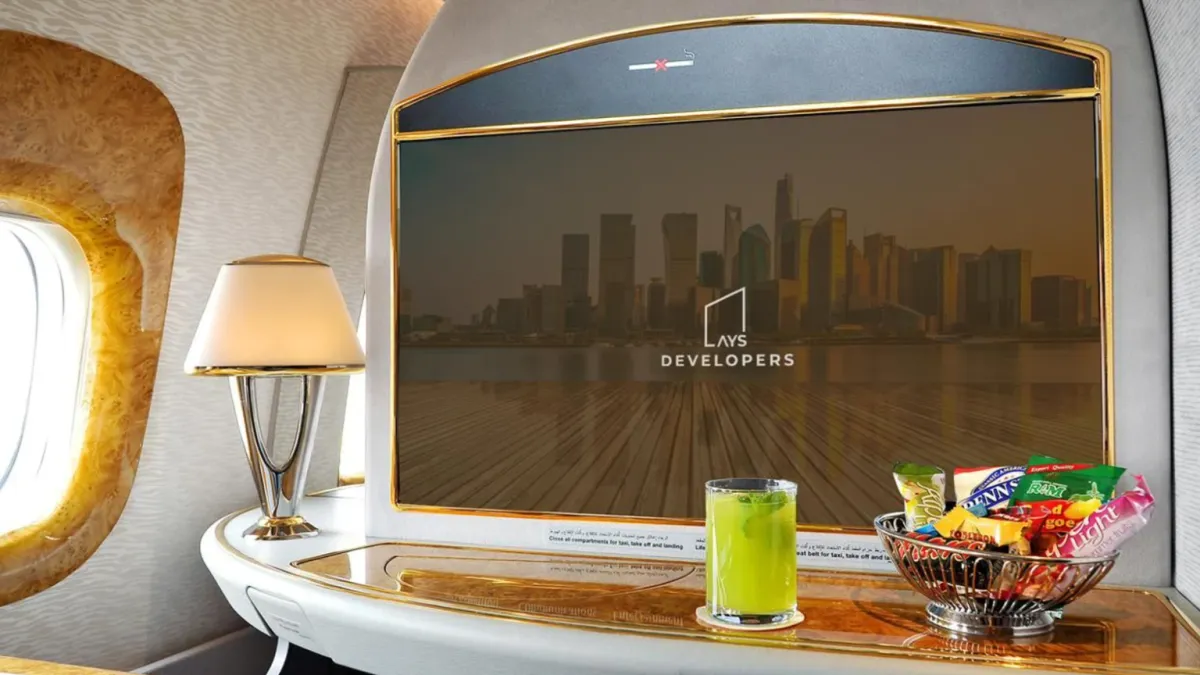
Industry: Property Development & Real Estate
Why This Format Works:
Inflight screen advertising offers AYS Developer access to a captive, affluent audience during their most relaxed and receptive travel phase. With passengers settled into their seats for 2-7 hours (depending on flight duration), inflight screens deliver unparalleled attention span for property marketing's complex messaging requirements.
Strategic Advantages:
- Affluent targeting: International flight passengers represent prime property investment demographics
- Extended consideration time: Long-haul flights provide sufficient time for passengers to contemplate significant purchases like property
- Dream-state psychology: Travel induces aspirational thinking—ideal for lifestyle property marketing
- Geographic relevance: Route-specific advertising targets passengers travelling to/from development locations
Time of Year Considerations:
- Q4 (October-December): Ideal for targeting end-of-year investors seeking tax advantages and property portfolio expansion
- Q1 (January-March): Captures New Year resolution-driven lifestyle changes and relocation planning
- Summer months (June-August): Targets families considering relocations before new school years commence
- Property launch cycles: Align advertising with specific development phase launches regardless of season
Industry-Specific Rationale:
Property development requires substantial consideration time and appeals to high-net-worth individuals. Inflight screens reach business class and premium economy passengers—precisely the demographic with investment capacity. The format allows showcase of property visualisations, location benefits, and ROI projections with sufficient complexity to drive qualified enquiries. For developments in the Gulf region, flights from London, South Asia, and Europe represent ideal target routes.
3. SolarWinds on DOOH Near Arrival Screens
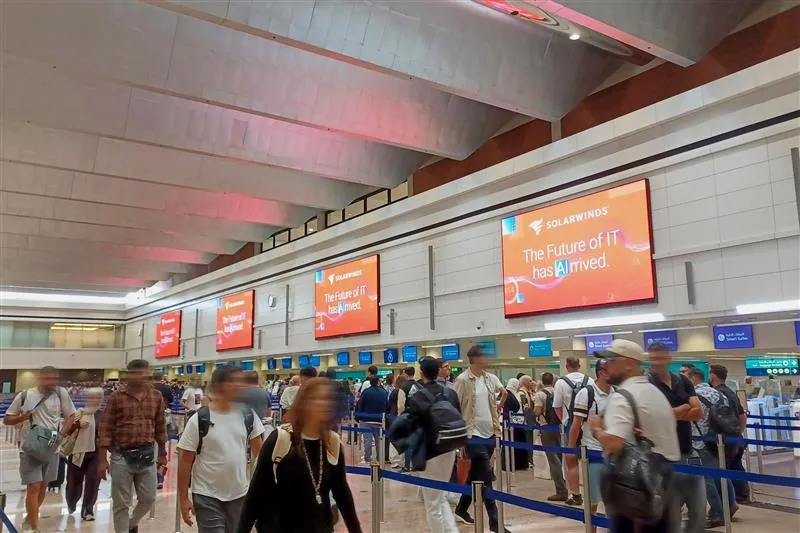
Industry: IT Infrastructure & Network Management Software
Why This Format Works:
Digital Out-of-Home (DOOH) placement near arrival screens strategically positions SolarWinds before business travellers at a critical psychological moment—the transition from journey to work mode. As passengers scan for their luggage carousel assignments, they're mentally shifting toward business priorities, making them receptive to B2B technology messaging.
Strategic Advantages:
- Business traveller concentration: Arrival areas have high densities of corporate decision-makers
- Attention convergence: Passengers naturally look toward information screens, ensuring ad visibility
- Professional context: The business travel setting primes receptivity to enterprise software messaging
- Dynamic messaging: DOOH allows time-of-day, route-specific, or event-triggered content variations
Time of Year Considerations:
- Conference seasons (March-May, September-November): Peak periods when IT professionals travel to industry events like AWS re:Invent, Microsoft Ignite, or Gartner symposiums
- Q4 budget cycles (October-December): Targets IT managers making final budget allocations and planning next year's infrastructure investments
- Avoid holiday peaks: Mid-December through early January sees primarily leisure travel, reducing B2B effectiveness
- Monday-Thursday focus: B2B travel concentrates on weekdays; weekend advertising delivers lower ROI
Industry-Specific Rationale:
Enterprise IT infrastructure purchases involve multiple stakeholders and extended sales cycles. Airport advertising serves awareness and consideration-building rather than immediate conversion. SolarWinds benefits from brand visibility amongst CIOs, IT directors, and network administrators who travel frequently for multi-site infrastructure management. The arrival screen placement catches them when they're thinking about connectivity, networks, and infrastructure—precisely SolarWinds' value proposition. This is particularly effective in hub airports serving tech centres like San Francisco, Austin, Seattle, London, and Singapore.
4. DWF Labs on Baggage Claim Belt Vertical Screens
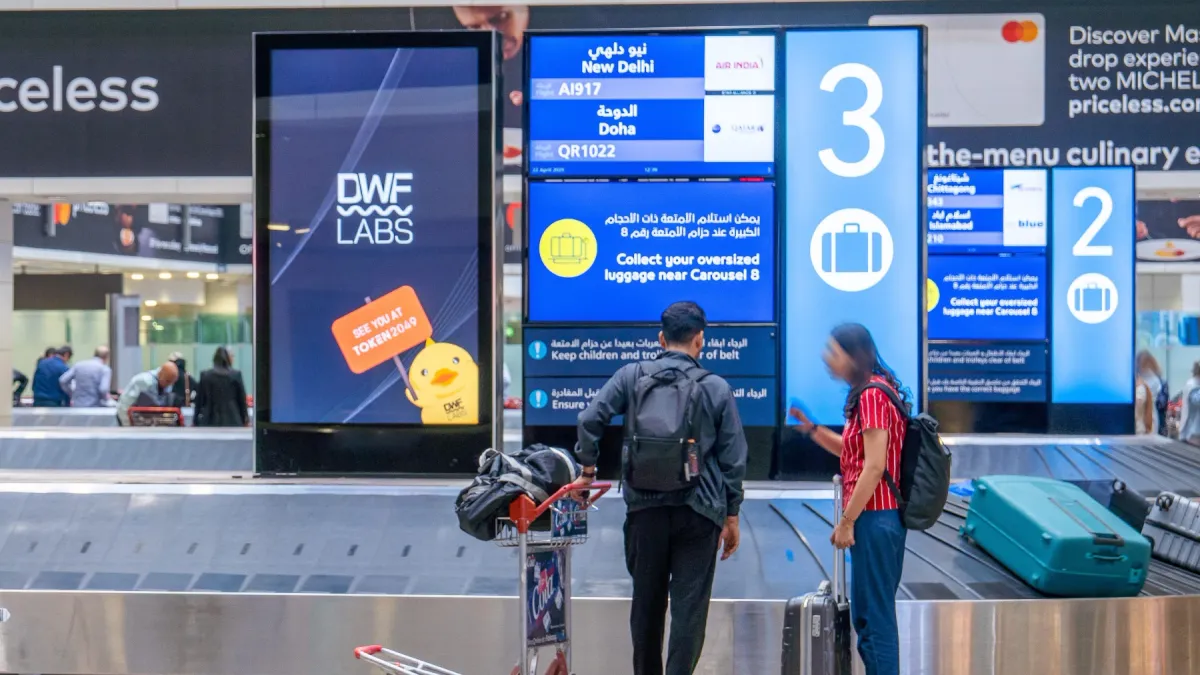
Industry: Web3 Investment & Digital Asset Market Making
Why This Format Works:
Baggage claim belt vertical screens offer DWF Labs a unique combination of high dwell time and a tech-savvy, internationally-mobile audience. Passengers waiting 15-25 minutes for luggage represent a genuinely captive audience with nowhere else to look, creating exceptional recall rates for complex Web3 messaging that requires viewer engagement.
Strategic Advantages:
- Guaranteed viewing time: Passengers must remain stationary facing screens whilst awaiting luggage
- Premium demographic targeting: International travellers over-index for cryptocurrency adoption and investment sophistication
- Repetitive exposure: Rotating advertising creates multiple impressions during single wait period
- Geographic precision: Target specific routes serving crypto-friendly jurisdictions or Web3 conference destinations
Time of Year Considerations:
- Major blockchain conferences: Time advertising around Consensus (May/June), Devcon (autumn), TOKEN2049 (March, September), and regional Web3 summits
- Tax year ends: March-April (UK/many Commonwealth nations) and December (US) when investors review portfolio allocations
- Market volatility periods: Increase presence during crypto bull runs when investor interest peaks
- Avoid crypto winters: Scale back during prolonged bear markets when investor appetite diminishes
Industry-Specific Rationale:
DWF Labs operates in digital asset market making and Web3 investment—industries requiring sophisticated understanding and serving globally-mobile investors and founders. Airport advertising positions them before:
- Crypto entrepreneurs travelling between Web3 hubs (Dubai, Singapore, Lisbon, Miami)
- Traditional finance professionals exploring digital asset exposure
- International investors with cross-border portfolio requirements
The baggage claim placement ensures visibility without competing with the immediate urgency of security checks or boarding. It reaches audiences in transition moments—ideal for introducing investment opportunities that require consideration rather than immediate action. For airports serving major crypto hubs like Dubai International, Singapore Changi, or Miami International, this placement directly reaches the Web3 ecosystem's most active participants.
5. Floki on Boarding Gates
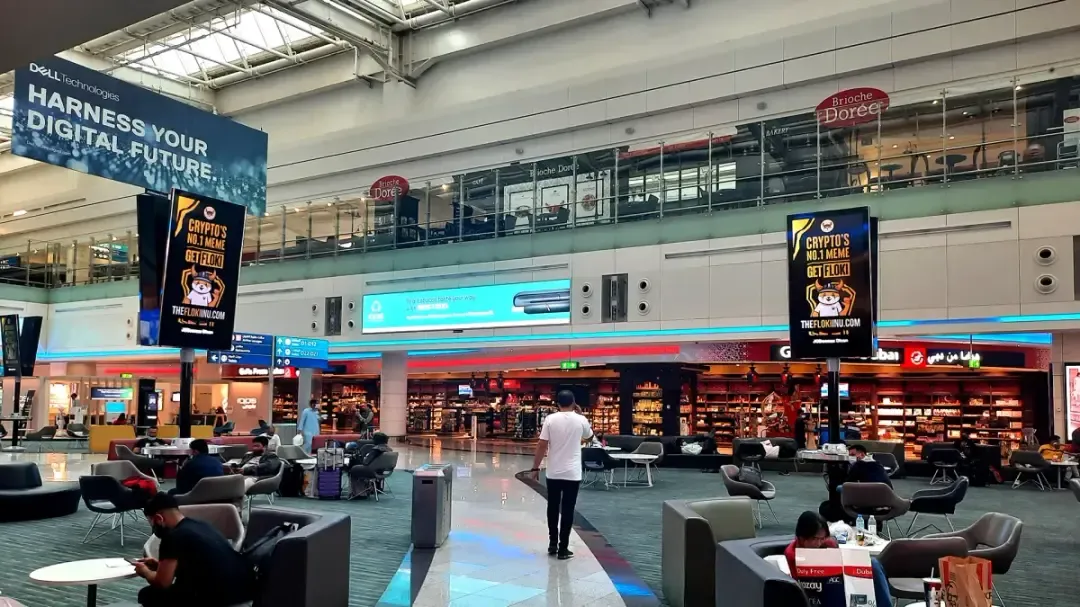
Industry: Cryptocurrency & Blockchain (Meme Coin with Utility Ecosystem)
Why This Format Works:
Boarding gate advertising captures passengers during peak anxiety and anticipation—emotional states that drive engagement with bold, attention-grabbing cryptocurrency messaging. With 30-60 minutes of pre-boarding dwell time, gate areas offer sustained exposure to mobile-active audiences ideal for crypto projects seeking community building and token awareness.
Strategic Advantages:
- Mobile device usage peak: Passengers actively use smartphones whilst waiting, facilitating immediate QR code scans and social media engagement
- Demographic concentration: International travellers over-index for early technology adoption and crypto awareness
- Social sharing environment: Distinctive crypto advertising prompts social media posts, extending reach beyond physical location
- Last impression before travel: Creates memorable brand recall during long flights, encouraging in-flight research
Time of Year Considerations:
- Bull market momentum (variable): Maximise spend during cryptocurrency market uptrends when retail interest peaks
- Holiday travel seasons (December, summer): Target younger, tech-savvy leisure travellers with disposable income
- Major sporting/cultural events: Align with World Cup, Olympics, or music festivals that attract Floki's demographic
- Token milestone periods: Intensify advertising around major ecosystem developments, exchange listings, or utility launches
Industry-Specific Rationale:
Floki represents the cryptocurrency sector's unique marketing requirements—balancing meme coin appeal with utility ecosystem credibility. Boarding gate advertising serves multiple objectives:
Community Building: Cryptocurrency projects thrive on community engagement. Gates serving routes to crypto-friendly nations (Dubai-bound flights from Europe, Singapore-London routes, South Korea connections) concentrate potential community members.
Brand awareness in competitive space: The cryptocurrency market is extraordinarily crowded. High-visibility airport placements establish legitimacy and scale perception—critical for projects seeking to differentiate from thousands of alternative tokens.
Viral potential: Gate advertising's photographable nature encourages social media sharing, amplifying reach through user-generated content—crucial for meme coin marketing strategies.
Global mindset alignment: Cryptocurrency adoption requires global perspective and comfort with digital-first finance. International travellers naturally possess these characteristics, making them ideal conversion prospects.
The boarding gate placement specifically works because it captures audiences during transition periods—when they're most open to new information and experiences. For a project like Floki that emphasises both community and utility (through metaverse, DeFi, and NFT initiatives), this format builds awareness that drives website visits, Telegram/Discord joins, and token purchases during and after travel.
Cross-Industry Insights Matching Format to Brand Objectives
High Consideration Purchases (Property, Enterprise Software)
Optimal formats: Inflight screens, DOOH near business areas Rationale: Extended exposure time accommodates complex messaging; targets affluent, decision-making demographics
Mass-Market Consumer Goods (FMCG)
Optimal formats: Trolleys, retail area adjacencies, departure hall dominations Rationale: Broad reach, positive practical associations, consistent year-round demand
Investment & Financial Services (Crypto, Web3, Asset Management)
Optimal formats: Baggage claim, business lounges, gate areas Rationale: Captive high-net-worth audiences with mobile devices active, enabling immediate engagement
Technology & Digital Services
Optimal formats: Charging stations, Wi-Fi landing pages, DOOH in business travel zones Rationale: Targets professional demographics actively using technology infrastructure
Strategic Alignment Drives ROI
Each brand's format selection demonstrates sophisticated understanding of:
- Passenger journey psychology – matching messages to mental states at specific touchpoints
- Demographic concentration – identifying where target audiences naturally congregate
- Attention economics – leveraging moments of captive attention versus transit
- Seasonal relevance – timing campaigns to industry cycles, travel patterns, and purchase behaviours
Successful airport advertising transcends mere visibility, creating contextually relevant brand encounters that align with passenger mindsets, industry sales cycles, and the unique attributes of each physical environment. The examples above illustrate how strategic format selection transforms airport advertising from simple exposure into targeted, high-impact marketing that drives measurable business outcomes.
by Harshit Dabhi
Enter your details and receive our free Media Kit.

Trusted by brands that soar high
Book some time with one of our media specialists and let’s explore how to maximize your next airport campaign.
Ready to let your business soar?
Complete your boarding card and let us take your company to the skies.
Gulf Airport Advertising

Elevate your brand with impossible to miss airport advertising.
12 international airports
284M+ annual passengers
42,000+ media touchpoints









